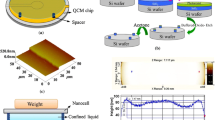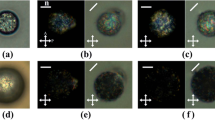Abstract
Carbon nanotube (CNT)-doped liquid crystals (LCs) have attracted intensive research studies as prospective materials in optic display devices, microfluidic sensors, and lubricants due to their unique molecular structures and properties. In this paper, the interaction between the doped CNTs and the hosting 4-cyano-4\(^{\prime }\)-pentylbiphenyl (5CB) molecules (in both nematic and isotropic phases) was investigated and we focused on the boundary layer rheological properties of the CNT-doped 5CB under external electric field. The experiments were performed by using a quartz crystal microbalance (for boundary layer viscosity investigation) and a rheometer (for bulk viscosity measurement). The results indicate that the bulk viscosity of the CNT-doped 5CB presents an obvious electroviscous effect in its nematic phase while no electroviscous effect in its isotropic phase. Additionally, we found that the boundary layer viscosity of the CNT-doped 5CB demonstrated significant electroviscous effects both in its nematic phase and isotropic phase. The enhanced electroviscous effects on the boundary layer viscosity of CNT-doped 5CB can be attributed to the highly ordered structures of LC molecules and CNTs on the substrate under external electric field. The unique properties of the boundary layer rheology of CNT-doped 5CB LC were further discussed in view of the ordering of LC molecules induced by the electric field, the polarity of CNTs, and the aligning interaction between CNTs and LC molecules.









Similar content being viewed by others
References
Bandey HL, Martin SJ, Cernosek RW (1999) Modeling the responses of thickness-shear mode resonators under various loading conditions. Anal Chem 71(11):2205–2214
Chen HY, Lee W (2006) Suppression of field screening in nematic liquid crystals by carbon nanotubes. Appl Phys Lett 88(22):222105
Chen HY, Lee W, Clark NA (2007) Faster electro-optical response characteristics of a carbon-nanotube-nematic suspension. Appl Phys Lett 90(3):033510
Deschamps J, Trusler J, Jackson G (2008) Vapor pressure and density of thermotropic liquid crystals: MBBA, 5CB, and novel fluorinated mesogens. J Phys Chem B 112(13):3918–3926
Dierking I, Scalia G, Morales P, LeClere D (2004) Aligning and reorienting carbon nanotubes with nematic liquid crystals. Adv Mater 16(11):865–869
Dierking I, Scalia G, Morales P (2005) Liquid crystal-carbon nanotube dispersions. J Appl Phys 97(4):044309
Jeon SY, Shin SH, Jeong SJ, Lee SH, Jeong SH, Lee YH, Choi HC, Kim KJ (2007) Effects of carbon nanotubes on electro-optical characteristics of liquid crystal cell driven by in-plane field. Appl Phys Lett 90(12):121901
Jiang WQ, Yu B, Liu WM, Hao JC (2007) Carbon nanotubes incorporated within lyotropic hexagonal liquid crystal formed in room-temperature ionic liquids. Langmuir 23(16):8549–8553
Jiao MZ, Ge ZB, Song Q, Wu ST (2008) Alignment layer effects on thin liquid crystal cells. Appl Phys Lett 92(6):061102
Kanazawa KK, Gordon JG (1985) Frequency of a quartz microbalance in contact with liquid. Anal Chem 57(8):1770–1771
Kuksenok OV, Ruhwandl RW, Shiyanovskii SV, Terentjev EM (1996) Director structure around a colloid particle suspended in a nematic liquid crystal. Phys Rev E 54(5):5198–5203
Lagerwall J, Scalia G, Haluska M, Dettlaff-Weglikowska U, Roth S, Giesselmann F (2007) Nanotube alignment using lyotropic liquid crystals. Adv Mater 19(3):359–364
Lee W, Gau JS, Chen HY (2005) Electro-optical properties of planar nematic cells impregnated with carbon nanosolids. Appl Phys B-Lasers and Optics 81(2–3):171–175
Lee SH, Lee HK, Lee SE, Lee YH (2007) Effects of carbon nanotubes on physical properties of nematic liquid crystal and liquid crystal devices. Proc SPIE 6487:64870U
Lynch MD, Patrick DL (2002) Organizing carbon nanotubes with liquid crystals. Nano Lett 2(11):1197–1201
Mccoll JR, Shih CS (1972) Temperature dependence of orientational order in a nematic liquid crystal at constant molar volume. Phys Rev Lett 29(2):85–87
McHale G, Lucklum R, Newton MI, Cowen JA (2000) Influence of viscoelasticity and interfacial slip on acoustic wave sensors. J Appl Phys 88(12):7304–7312
Nakano K (2003) Scaling law on molecular orientation and effective viscosity of liquid-crystalline boundary films. Tribol Lettt 14(1):17–24
Nie XY, Lu RB, Xianyu HQ, Wu TX, Wu ST (2007) Anchoring energy and cell gap effects on liquid crystal response time. J Appl Phys 101:103110
Rahman M, Lee W (2009) Scientific duo of carbon nanotubes and nematic liquid crystals. J Phys D Appl Phys 42:063001
Sand PN, Dove DB, Ong HL, Jansen SA, Hoffmann R (1989) Role of surface bonding on liquid-crystal alignment at metal surfaces. Phys Rev A 39(5):2653–2658
Scalia G, Lagerwall J, Schymura S, Haluska M, Giesselmann F, Roth S (2007) Carbon nanotubes in liquid crystals as versatile functional materials. Phys Stat Sol (B) 244(11):4212–4217
Sharma D (2010) Non-isothermal kinetics of melting and nematic to isotropic phase transitions of 5CB liquid crystal. J Therm Anal Calorim 102(2):627–632
Thompson M, Kipling AL, Duncanhewitt WC, Rajakovic LV, Cavicvlasak BA (1991) Thickness shear mode acoustic wave sensors in the liquid phase—a review. Analyst 116(9):881–890
Voinova MV, Rodahl M, Jonson M, Kasemo B (1999) Viscoelastic acoustic response of layered polymer films at fluid-solid interfaces: continuum mechanics approach. Phys Scripta 59(5):391–396
Weiss V, Thiruvengadathan R, Regev O (2006) Preparation and characterization of a carbon nanotube-lyotropic liquid crystal composite. Langmuir 22(3):854–856
Zhang XJ, Zhang XH, Xiong Y, Tian Y, Wen SZ (2012) Anti-electroviscous effect of near-surface 5CB liquid crystal and its boundary lubrication property. Rheol Acta 51(3):267–277
Acknowledgments
This research is sponsored by the National Basic Research Program of China (973, grant no. 2012CB934101) and the National Natural Science Foundation of China (grant nos. 50975154 and 51175282)
Author information
Authors and Affiliations
Corresponding author
Rights and permissions
About this article
Cite this article
Qiao, X., Zhang, X., Guo, Y. et al. Boundary layer viscosity of CNT-doped liquid crystals: effects of phase behavior. Rheol Acta 52, 939–947 (2013). https://doi.org/10.1007/s00397-013-0732-4
Received:
Revised:
Accepted:
Published:
Issue Date:
DOI: https://doi.org/10.1007/s00397-013-0732-4




